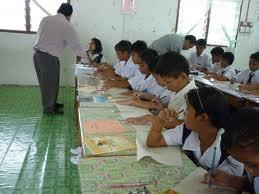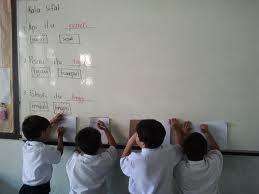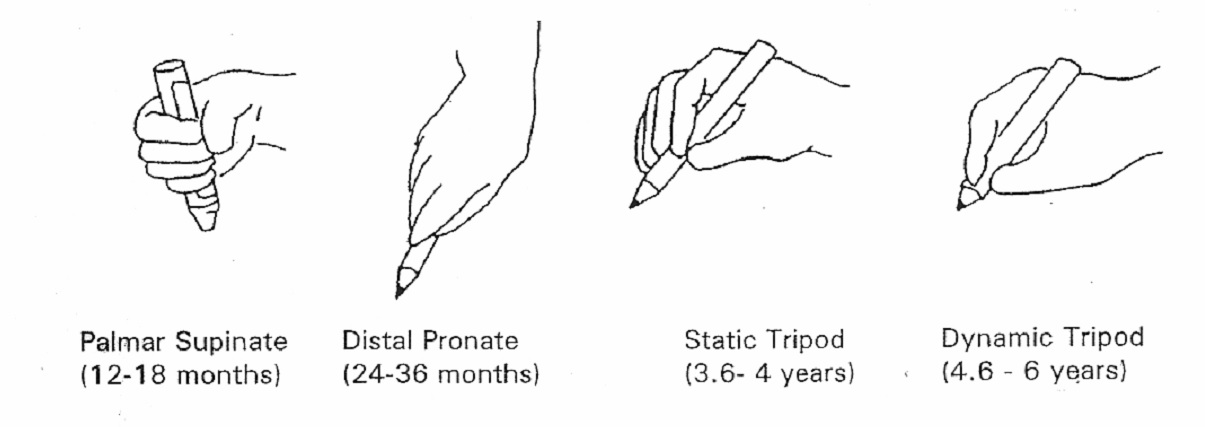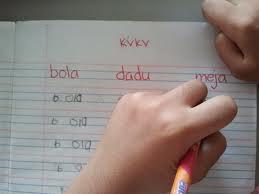Introduction
Handwriting still plays an important functional role although we are in the modern era of technology. It is frequently used by children at school where it involves complex process of handling language by pencil grip, letter formation, and body posture. Handwriting efficiency requires mastery of multiple skills, including vision, coordinating the eyes, arms, hands, memory, posture and body control.
In class, predominant task is writing. Approximately 30% to 60% of class time in primary school is spent in fine motor and writing activities. (McHale & Cermat, 1992) Children who struggle with handwriting may have trouble taking notes, tests or completing their schoolwork. This can affect their self-esteem, academic performance and attitude toward school.
 |
 |
Normal Development for Handwriting
Many children begin to scribble on paper shortly after they are able to grasp a writing tool and if not supervised, they will eventually write on any available surface.
|
Age level |
Performance task |
Pencil graps development |
| 10-12 months | Scribbles on paper | commonly begin by holding the pencil with the whole hand |
| 2 years | Initiates horizontal, vertical and circular Marks on paper |
children use a more mature pencil grasp, holding the pencil between the distal phalanges of the thumb, index and middle fingers |
| 3 years | Copies a horizontal line, vertical line and Circle |
|
| 4-5 years | Copies a cross, right oblique line, left oblique cross, some letters and numbers and maybe able to write own name | |
| 5-6 years | Copies a triangle, prints own name, copies most upper and lower case letters | At this later stage, the forearm is usually supinated and the intrinsic muscles of the hand move the pencil |
 |
| Source: RP Erhardt, 1992 |
Handwriting Readiness
The readiness factors needed for writing involves integrity of a number of sensory-motor systems. Six prerequisites that children must have prior to handwriting are:
-
Small muscle development
-
Eye-hand coordination
-
Ability to hold utensils or writing tools
-
Capacity to smoothly form basic strokes such as lines and circles
-
Letter perception, including the ability to recognize forms, notice likeness and differences, infer the movements necessary for the production of form and give accurate verbal descriptions of what is seen
-
Orientation to printed language, which involves the visual analysis of letters and words along with right/left discrimination.
 |
Signs of Handwriting Problems
Kids develop at different rates. Some kids have trouble learning the direction letters go in and others struggle to write neatly. Sometimes writing problems can be a sign of other issues such as developmental delay or learning disabilities. Conditions that can affect a child’s ability to write include:
-
memory problems that prevent a child from remembering spelling, grammar, or punctuation rules
-
language problems that cause difficulty with word pronunciation, spelling, and sentence structure
-
visual or sequential ordering problems that cause uneven spacing of words, and inability to make lists or put ideas in order
-
dysgraphia, a neurological disorder characterized by writing difficulties (such as distorted letters or misspellings) regardless of reading ability
-
Attention deficit hyperactivity disorder (ADHD)
Children who have special needs also may have trouble learning to write. Signs that a child may need additional assistance with learning to write include:
-
awkward pencil grip and body position
-
illegible handwriting, letters of different sizes
-
difficulty forming letters
-
an inability to concentrate and complete writing tasks
-
avoiding writing or drawing activities
-
many misspelled words
-
letters or words that don’t follow correct sequence
-
incorrect placement of words on the page
-
uneven spacing between letters
-
a large gap between spoken language and writing ability
-
an exceptionally slow and difficult time writing
-
unfinished words or sentences
Handwriting Intervention
Occupational Therapy frames of reference that apply to designing handwriting intervention programs include:
-
Neurodevelopment – to execute normal postural responses and movement patterns.
-
Sensory integration – providing various sensory opportunities the child’s nervous system may integrate information more efficiently to produce a satisfactory motor output.
-
Biomechanical – Focuses on the ergonomic factors of sitting posture, paper position, pencil grasp, writing instruments and type of paper in training the handwriting skills.
-
Behavioral – employ activities to enhance children’s social competence while participating in a handwriting intervention group
-
Acquisitional – focus on a structured progression of introducing and teaching letter and numeral forms
Playing Promote Handwriting readiness
Problems need to be ruled out before trying to help a child who’s experiencing handwriting difficulties. If the child struggles with fine motor skills or forming letters, it is likely a physical problem. If the child can’t remember how to form a letter of the alphabet or take too long deciding what to write, there could be cognitive issues.
Most handwriting problems are physical. Both fine motor practice and gross motor play is equally important. Handwriting involves body posture and proper use of hands, arms, head, and eyes. Below are some play activities that could enhance handwriting readiness:
-
Playground activities – play with swing, slide and monkey bar enables children to climb, hang and jump. These activities help children in stimulating the all sense of sensory.
-
Outdoor play activities – playing “human wheelbarrow”, crawling through tunnel, badminton and basket ball game help connect the motor-neural pathways needed for handwriting
-
Traditional game & clap songs – engage child in games that require eye-hand coordination such as ‘batu seremban’, ‘if you’re happy’, pick-up sticks, marbles and ‘teng teng’.
-
Cooking time – cook with your child. Let them knead dough, roll it out and cut it with cookie cutters or play with baking set.
-
Sculpting with play dough or clay
-
Origami or paper cutting
-
Finger writing – drawing lines and copying shapes using shaving cream, sand trays or finger paints
-
Picking up small objects with tweezers
-
Twisting open a small tube of tooth paste with the thumb, index and middle fingers while holding the tube with the ulnar digits.
-
Dress the doll – buttoning, zipping and undress, lacing and tying the doll’s cloth.
| Last Review | : | 28 August 2020 |
| Writer | : | Nor Zuhaila bt Mahmad Azmi |
| Accreditor | : | Rejina A/P Maniam |
| Reviewer | : | Tan Foo Lan |







